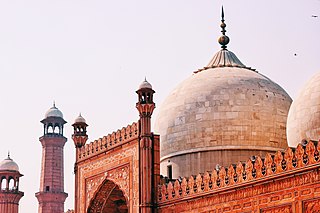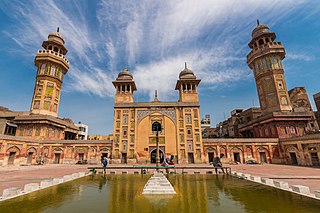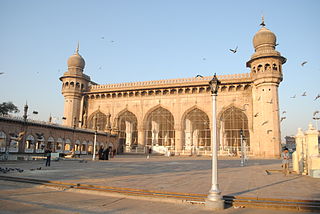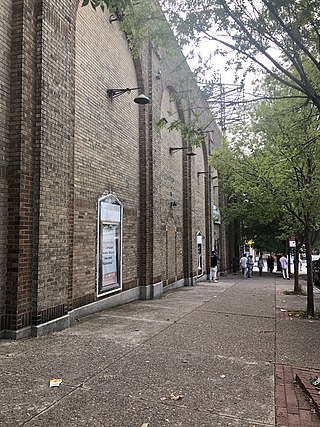
The Architecture of Lahore reflects the history of Lahore and is remarkable for its variety and uniqueness. There are buildings left from the centuries of rule of the Mughal Empire, the Sikh Empire, as well as from the era of the British Raj, whose style is a mixture of Victorian and Islamic architecture often referred to as Indo-Saracenic. In addition, there are newer buildings which are very modern in their design. Unlike the emphasis on functional architecture in the west, much of Lahore's architecture has always been about making a statement as much as anything else.

The Wazir Khan Mosque is a 17th-century Mughal masjid located in the city of Lahore, Punjab, Pakistan.

The Charminar is a monument located in Hyderabad, Telangana, India. Constructed in 1591, the landmark is a symbol of Hyderabad and officially incorporated in the emblem of Telangana. The Charminar's long history includes the existence of a mosque on its top floor for more than 425 years. While both historically and religiously significant, it is also known for its popular and busy local markets surrounding the structure, and has become one of the most frequented tourist attractions in Hyderabad. Charminar is also a site of numerous festival celebrations, such as Eid-ul-adha and Eid al-Fitr, as it is adjacent to the city's main mosque, the Makkah Masjid.

The Masjid-i-Jehan-Numa, commonly known as the Jama Masjid of Delhi, is one of the largest Sunni mosques in India.

Adoni or Adavani is a city in the Kurnool district in the Indian state of Andhra Pradesh. It is a municipality and the headquarters of Adoni mandal, administered under the Adoni Revenue Division. In the 2011 census of India, Adoni had a population of 166,344, making it the 16th most populous town in the state with an urban agglomeration population of 184,625.

Makkah Masjid or Mecca Masjid, is a congregational mosque in Hyderabad, India. It is the largest mosque in the city, and one of the largest in the country, with a capacity of 10,000 people. The mosque was built during the 17th century, and is a state-protected monument. It serves as the primary mosque for the Old City of Hyderabad, and is located close to the historic landmarks of Charminar, Chowmahalla Palace and Laad Bazaar.

Indo-Islamic architecture is the architecture of the Indian subcontinent produced by and for Islamic patrons and purposes. Despite an initial Arab presence in Sindh, the development of Indo-Islamic architecture began in earnest with the establishment of Delhi as the capital of the Ghurid dynasty in 1193. Succeeding the Ghurids was the Delhi Sultanate, a series of Central Asian dynasties that consolidated much of North, East, and Central India, and later by the Mughal Empire during the early 16th century. Both of these dynasties introduced Islamic architecture and art styles from West Asia into the Indian subcontinent.

The Jamia Masjid is a Friday mosque, located at Nowhatta in the Old City of Srinagar, in the union territory of Jammu and Kashmir, India. The mosque was commissioned by Sultan Sikandar in 1394 CE and completed in 1402 CE, at the behest of Mir Mohammad Hamadani, son of Mir Sayyid Ali Hamadani, and is regarded as one of the most important mosques in Kashmir. The mosque is located in a central zone in the religio-political life in Srinagar. Thronged by Muslims every Friday, it is a prime tourist attraction of the city.
Malka is a town and union council of Gujrat District, in the Punjab province of Pakistan. It is part of Kharian Tehsil and is located at 32°51'0N 73°59'0E with an altitude of 285 metres. Malka village is 8 km from Guliana on the main Manglia Road. This road goes to Manglia, Thoota Rai Bahadur, and passing along different villages connects to Azad Kashmir.
Dakshin Shahbazpur or South Shahbazpur is a Union Parishad under Barlekha Upazila of Moulvibazar District in the division of Sylhet, Bangladesh. It has an area of 40.46 square miles and a population of 26,840.

Atala Masjid or Atala Mosque is a 14th-century mosque in Jaunpur, Uttar Pradesh, India.

Baro Shona Masjid, also known as Baroduari Masjid, is located in Gour, West Bengal, India. Completed in 1526, it is situated half a kilometer south of Ramkeli, a village on the way to Gour, and 12 km south of Malda. The mosque with its ruins can be found very close to the India-Bangladesh border. With a gigantic rectangular structure of brick and stone, this mosque is the largest monument in Gour. Even though one of the mosque's names "Baroduari Masjid" implies that it has 12 doors, it actually has eleven in its current state.

Athar Jamad Masjid is located at Oppanakara Street within the Coimbatore district of Tamil Nadu in India. It is one of the oldest and biggest masjid in Coimbatore.

Persian Inscriptions on Indian Monuments is a book written in Persian by Dr Ali Asghar Hekmat E Shirazi and published in 1956 and 1958 and 2013. New edition contains the Persian texts of more than 200 epigraphical inscriptions found on historical monuments in India, many of which are currently listed as national heritage sites or registered as UNESCO world heritage, published in Persian; an English edition is also being printed.

Masjid Al-Jamia is a Sunni mosque in West Philadelphia. It was founded in 1988 by members of the Muslim Students Association at the University of Pennsylvania . Eight years later, the mosque became independent from the Penn MSA and, around 2009, acquired ownership of the building. Located at 4228 Walnut Street, in a historic building formerly occupied by the Commodore Theatre, the mosque currently serves a large and diverse Muslim population in the neighborhood. The mosque's name itself signals its importance to the community, as the Arabic etymology suggests. In Arabic, Masjid Al-Jamia means “the congregational mosque”, typically where Muslims meet for Friday prayers.
Prithimpassa Union is a Union Parishad under Kulaura Upazila of Moulvibazar District in the division of Sylhet, Bangladesh. It has an area of 21 square kilometres and a population of 18,053.

Jamia Uloom Al-Islamia Al-Faridia, commonly known as Jamia Faridia, is a Deobandi Islamic university situated near the Faisal Mosque in Sector E-7 of Islamabad, Pakistan. The university was established in 1971 by Sheikh al-Hadith Mawlānā Abdullah Ghazi, who remained the Chancellor until he was assassinated by unknown gunmen in October 1998.















